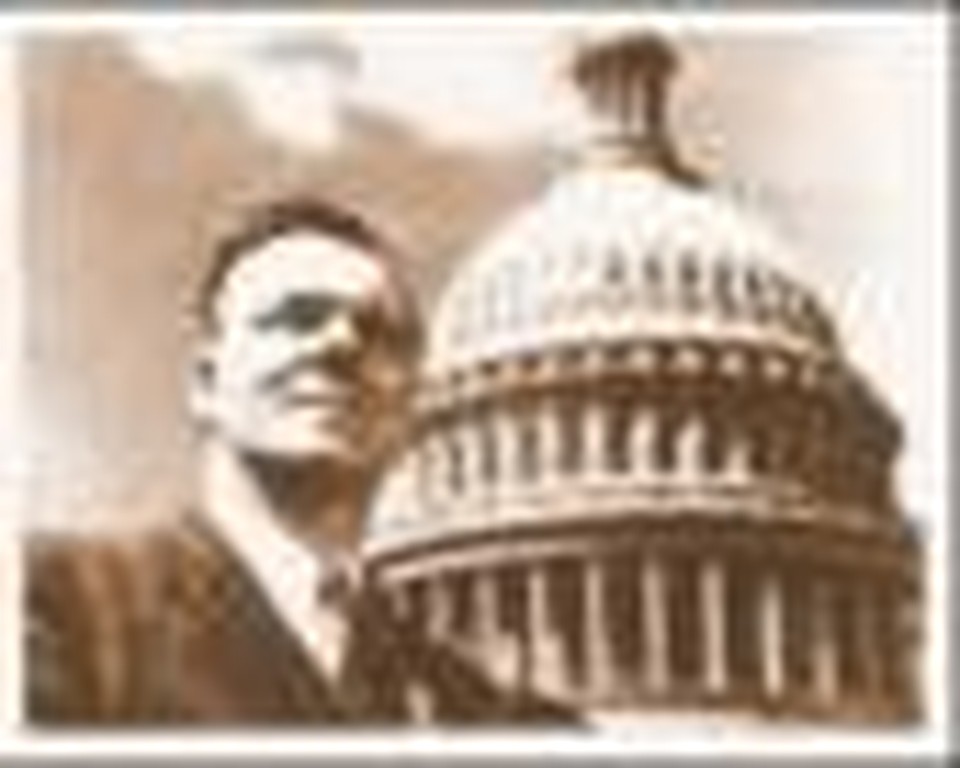Peter Marshall: Preaching with a Sanctified Imagination

Peter Marshall often said, "Spirituality is a matter of perception, not proof." His wife, Catherine, claimed this statement was his favorite thought. This statement also stands as the defining commentary on his imaginative preaching.
Most preachers in the first half of the 20th century relied on rhetoric to proclaim God's truth. Marshall decided to paint word pictures for his listeners. He dazzled his audience with a poetic language that evoked the feelings of his hearers and
connected their feelings to biblical facts. His unique style prompted his ministerial friends in Washington, D.C., to nickname him "Twittering Birds Marshall."1
Some people who heard Marshall preach supposed he came by his poetic speech naturally. He was born in the land of Bobby Burns and could lapse into his Scottish brogue at the first sound of a bagpipe. Like many Scots, his language had a musical quality that appealed to many listeners, especially in America where he ministered.
Marshall was born in 1902 in Coatbridge, Scotland, an industrial area nine miles from the sea. The lure of the sea enticed the young Marshall to join the British Navy at age 14. The Navy, however, only accepted volunteers at 15 years nine months, so he was forced to return home, where an alcoholic stepfather made life difficult. Even though Marshall worked full time and attended night school in which he studied mechanical engineering, his broken relationship with his stepfather compelled him to move out of his parents' home at age 20.
Marshall surrendered to Christian ministry after hearing a missionary from China appeal for workers. Because Marshall had neither the education required by the London Missionary Society nor the money to obtain it, he traveled to America, where his cousin said he could earn a living and train for the ministry. His first few months in his new country, however, were anything but promising. He commented on his early days in New Jersey in a sermon: "I worked hard for long hours. I dug ditches. I wielded spade and shovel. I was unemployed."2
A friend encouraged Marshall to move south. After earnestly praying for God's guidance, he relocated to Birmingham, Alabama. In a few weeks he started working at The Birmingham News, joined the First Presbyterian Church, became the president of the church's organization for young people, accepted the teacher's position for the men's Bible class and began making preparation to attend seminary. His personal struggles and hard work during his early years wove their way into his preaching and gave his listeners something with which to identify.
Marshall first heard about a "sanctified imagination" as a student at Columbia Theological Seminary in Decatur, Georgia. He explained to David Simpson, a classmate, his thinking about preaching with a sanctified imagination: "What we need to do is take a passage of Scripture and so carefully and accurately reconstruct the context of it that the scene comes to life. We see it first ourselves. Then we take our listeners to the spot in imagination. We make them see and hear what happened so vividly that the passage will live forever in their minds and hearts."3
Marshall used imagination not only to recreate the historical setting of Scripture but also to evoke the memories of his listeners and associate their personal experiences with the meaning of the biblical passage. Like Jesus, Marshall drew upon images with which his listeners could easily identify, and he used these images to convey the meaning of Scripture. Then he used the images to establish new relationships between the meaning of the passage and the current situations of his listeners.
Most of his sermons were not expository messages, but they were definitely biblical. His sermons would more appropriately be described as topical. He took the idea of the sermon from the text and developed it apart from the passage. Nevertheless, he generally bolstered his idea with several Scriptures outside the text. He believed the Bible was God's authoritative and inspired revelation to reveal Christ and instruct believers in Christian living.
Marshall used his imaginative preaching with worshipers in church and people who heard him in non-religious settings. He was pastor of New York Avenue Presbyterian Church in Washington, D.C., from 1937-1949, where he spoke to overflow crowds as he had done in his previous two pastorates. Two years before his untimely death in 1949, he was elected chaplain of the United States Senate. Each day's activities began with prayer, but few senators interrupted their political conversations to listen—until Marshall became chaplain. His straight-forward appeals to God for guidance over the Senate's deliberations compelled senators to cease talking and listen as Marshall prayed.
As the United States rapidly became a dominant force in the world for freedom, the senators heard him pray in March of 1947, "Save us from accepting a little of what we know to be wrong in order to get a little of what we imagine to be right."4 Then about a month later Marshall prayed, "We know, our Father, that there is a time to speak and a time to keep silence. Help us to tell the one from the other. When we should speak, give us the courage of our convictions. When we should keep silence, restrain us from speaking, lest, in our desire to appear wise, we give ourselves away."5 Soon the Senate chambers filled with government workers who came to hear Marshall pray. The Associated Press and prominent magazines, such as Reader's Digest, began to print his prayers and enabled him to captivate a national audience with his "sanctified imagination."
Marshall never thought his sermons were good enough to publish; but nine months after his death from a heart attack, his wife published 12 sermons in Mr. Jones, Meet the Master (1949) and six more in his biography, entitled A Man Called Peter (1951). An additional 12 messages for young people were published in John Doe, Disciple (1963), and all his senatorial prayers appeared in The Prayers of Peter Marshall (1954).
Marshall believed and preached a conservative theology, but he did not try to prove it. He portrayed it in pictures that his listeners could hang on the walls of their minds—pictures they could trust to help them understand spiritual reality. Preaching with a sanctified imagination also allowed Marshall to follow the Spirit's direction in developing his pictorial preaching. His method is worthy of study because this style never goes out of fashion, always attracts hearers and appeals to the imagination in everyone.
1. Catherine Marshall, A Man Called Peter (New York: McGraw-Hill Book Company, Inc., 1951), 41.
2. Peter Marshall, Mr. Jones, Meet the Master (Old Tappan, NJ: Fleming H. Revell Company, 1949; reprint, Robert Schuller Ministries, 1988), 12.
3. Catherine Marshall, ed., John Doe, Disciple (New York: McGraw-Hill Book Company, Inc., 1963), 124-5.
4. Catherine Marshall, ed., The Prayers of Peter Marshall (New York: McGraw-Hill Book Company, Inc., 1954), 152.
5. Ibid., 158.
Originally published February 04, 2010.




